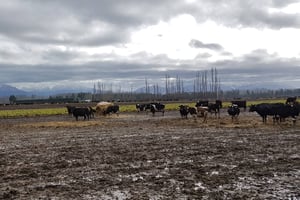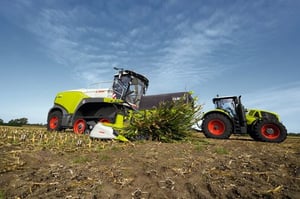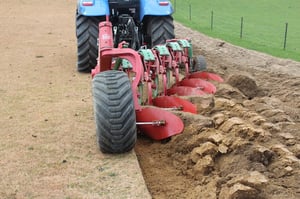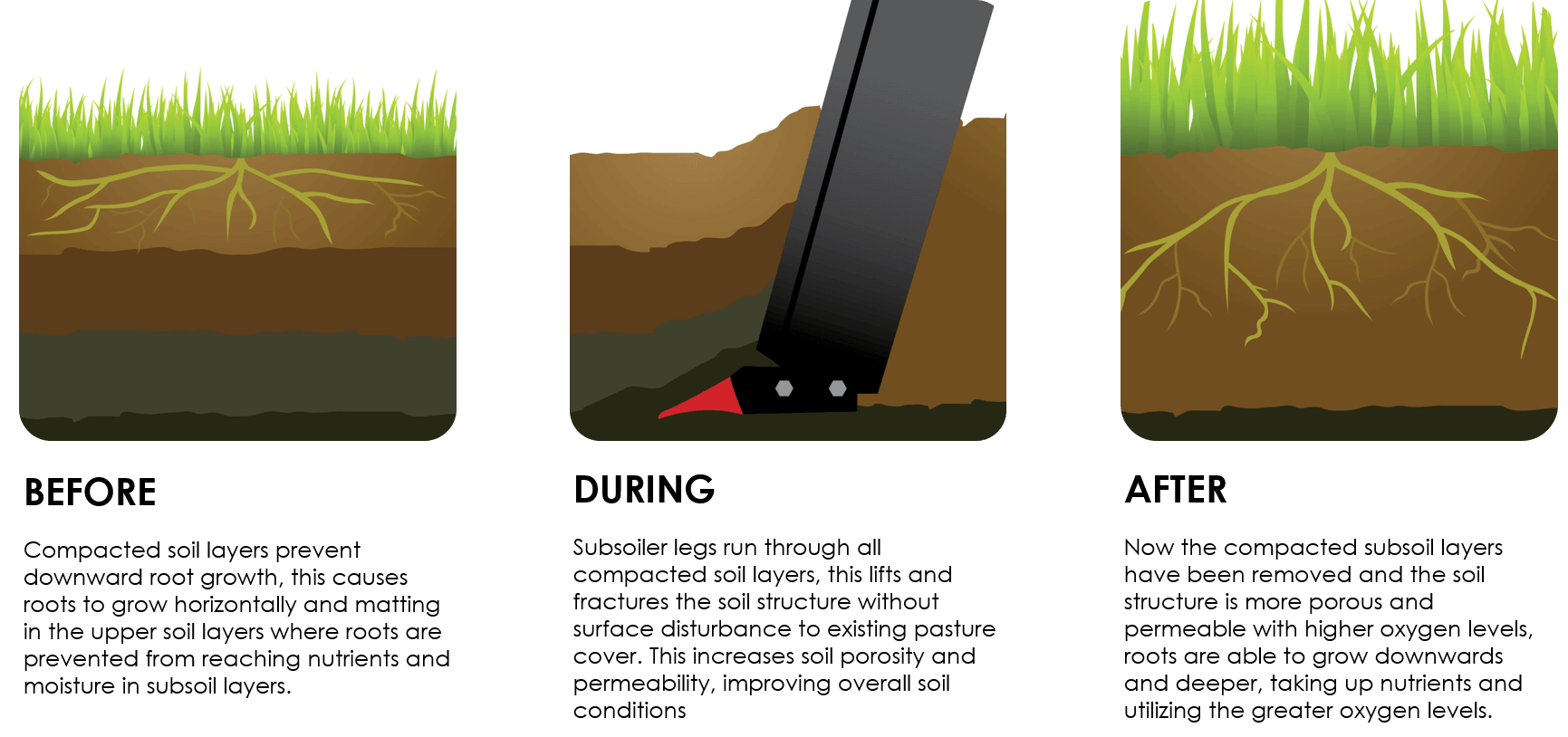Find all you need to know about Subsoil Aeration and overcoming compaction!
Don't have time to read it all now? Download the information on this page here
Subsoil Aeration Guide: Download Here
Subsoil Aeration is the term used to describe the loosening of the subsoil structure along with the removal of any compacted layers to create a more porous and aerated soil in which nutrients along with water can flow. This increase in soil permeability enables fertilisers and nutrients to flow to the root zone to be taken up more effectively and also for the roots themselves to grow more vigorously as the resistance becomes less.
This more vigourous root growth allows roots to grow to deeper levels making the pasture and crop more resilient to summer drys and winter wet periods.
The benefits of subsoil aeration are many, but can be summed up with a general increase in pasture growth or crop yields of 20% when done correctly (more in some circumstances).
Soil compaction occurs when the soil particles come under force that pushes them closer together, closing up the pore space between them and creating a tight soil structure that becomes relatively impenetrable to water, air and plant roots themselves.
This compaction is often attributed to being caused by one of the (in some cases all) factors on most farms:
 Pugging
PuggingAs stock numbers are intensified in smaller areas over the winter months along with more moist soil conditions the weight of the stock is transferred into the ground causing pugging which in turn compacts the soil as the structure is broken down and soil becomes compacted, as the soil drys out the soil remains in this compacted state and becomes less porous.
Find out how to prevent and minimise pugging here: How to prevent and repair winter pugging damage in pastures
 Machinery
MachineryWhen machinery and vehicles traffic pastures and paddocks they transfer their operating weight onto the ground and much like the pugging affect it closes up the soil structure making it less porous. Mechanical compaction tends to be the main cause of compaction in arable cropping soils as large, heavy machinery traffics the surface at the time of harvest.
 Plough Pans
Plough PansPans occur as a result of repeated tillage operations which cause a layer of higher density soil to form which acts as a barrier to root growth along with the transfer of water and nutrients through the soil.
The different effects of soil compaction all result from the same root cause, from the layer of soil with a higher density and lower level of porosity which inhibits the transfer of water, air and nutrients resulting in an overall reduction of pasture production and crop yeilds.
In addition to low pasture growth and crop yields, other soil compaction effects can include:
.jpg?width=300&name=Effect%20of%20soil%20compaction%20(1).jpg) Water Ponding
Water PondingAs soils become compacted and pores close up, water becomes less able to drain which causes it to pond in lower lying areas for extended periods. Take particular notice of surface water still present long after rain events.
.jpg?width=300&name=Effect%20of%20soil%20compaction%20(2).jpg) Shallow Roots
Shallow RootsCompacted soil are hard for roots to penetrate which can cause them to grow horizontally in a 'matt'. This shallow depth of root growth makes the plant more susceptible to climatic extremes such as periods of hot dry weather.
.jpeg?width=300&name=Effect%20of%20soil%20compaction%20(3).jpeg) Low Fertiliser Response
Low Fertiliser ResponseAs soils become compacted plants respond less to fertiliser applications, this is due to fertiliser not being able to absorb into the ground as well along with reduced space for root growth.
Check out our: 5 Tips for effective fertiliser spreading
Given the ability of a farm to generate revenue is closely tied to its pasture growth or crop yeilds, anything to do with either should warrant the attention of farmers.
Soil compaction comes with a cost of reduced pasture and crop outputs - this also means if treated farmers can benefit from significant increases in pasture productivity and crop yields.
Research across multiple industry bodies shows that a seriously compacted pasture will produce less than 40% dry matter than it's 'un-compacted' equivalent in the following growing season. In some cases yield reductions of up to 80% have been observed.
Working with the example pasture production of 14,000kg DM/ha at a value of $0.2/kg DM the cost of reduced pasture production due to compaction can look like:

.jpeg)
.jpeg)
Feed out area's are high risk compaction zones as stock congregate in these areas in high numbers frequently.
.jpg)
.jpeg)
As machinery and stock are all forced to pass through small spaces such as gateways, these areas tend to become very compacted over time.
.jpeg)
.jpeg)
When large soil clods are present after tillage it can be indicative of poor soil aggregation as a result of soil compaction issues.
.jpeg)
Low growth areas in pastures and paddocks are a sign of compaction causing root growth issues.
.jpg)
As soil compacts it becomes harder for roots to penetrate deep, this causes roots to grow laterally into a matt along the upper soil layers.
Subsoil aeration is most effectively achieved by working the ground with a subsoiler style of aerator. This is due to the subsoiler's ability to rip deep into the subsoil and shatter the hard packed layers of soil, lifting the ground and allowing oxygen, fertiliser and moisture to flow freely through the ground at the plant root level. Care must be taken not to subsoil too deep (more than 450mm in most NZ soil types) as this, aside from being a waste of fuel and wearing parts, means that the water level could drop too low.

Actual Panerazer Leg and foot assembly shown.
Infographic for illustrative purposes only.
Oxygen activates microorganisms in the soil that produce plant nutrients. This release of nutrients makes increased growth possible. When the soil is too tightly packed, or the soil pores filled with water, these microorganisms cannot access the oxygen they need to function and produce plant nutrients. This symbiotic relationship between the plants and microorganisms can be managed for maximum effect to the farmer through the use of Subsoil Aerators.
A shattered soil structure means the surface water can recede to a lower level helping to overcome issues with excess surface water & ponding. This does also mean subsoil aeration should be done at the right time if being performed in preparation for a new crop, so the upper soil water levels do not become too low & drying out the surface layers of the soil before the root system is able to reach the sub soil.
Growing plants is a fine balance between proving enough oxygen to the roots and therefore nutrients, versus providing the right amount of water, which stops soil microorganisms from producing nutrients. This is what makes the Subsoil Aerator such a powerful tool in the farmer's repertoire as it gives the operator control of water and aeration levels in the soil, enabling conditions in field to be controlled precisely.
Find out How to aerate soil effectively
The below infographic shows how this works:

As shown in the above pictures subsoil aerating removes the compacted soil layers, this brings many benefits such as:
Improved Soil Drainage: In aerated soils the ability of water to drain improves, this means surface water can drain down into the subsoils eliminating ponding and reducing surface runoff.
Deep Root Growth: Soil compaction seriously hampers root growth, when the compaction is removed roots are able to grow more freely, growing deeper and more vigorously - in turn resulting in enhanced plant health.
Greater Fertiliser Response: Fertiliser is wasted on compacted soils as it does not absorb into the soil well, this means it often vaporises into the atmosphere or washes off. When soils are permeable fertiliser can absorb into the soil better to be taken up by the roots.
Improved Soil Porosity: As compaction is removed the soil becomes more porous, improving the level of oxygen and carbon dioxide in the soil, as oxygen levels increase plant growth increases significantly.
Increase in pasture growth: This is the reason why farmers aerate soils! The combined factors of subsoil aeration have been proven to increase pasture dry matter yield by 28% in the right conditions, increasing growth, production and profits.
A conventional subsoiler for smaller hp tractors.
Ideal for tractors up to 120hp with a working depth of up to 350mm
The most popular subsoil aerator!
Working depth of up to 450mm with 5, 7 and 9 leg models available - Requires approx. 25hp/leg
Ideal for harsh ground.
Working depth of up to 450mm with 5, 7 and 9 leg models available - Requires approx. 25hp/leg
Copyright. 2023 Rata Industries Group